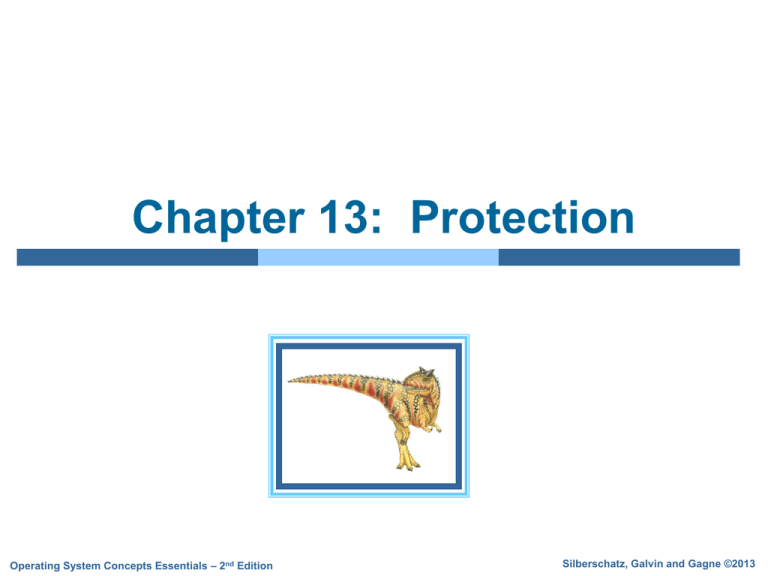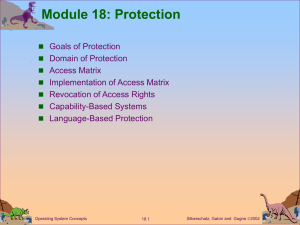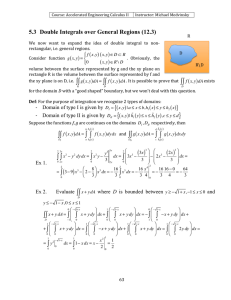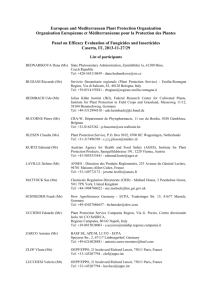Chapter 13: Protection Silberschatz, Galvin and Gagne ©2013 – 2
advertisement

Chapter 13: Protection Operating System Concepts Essentials – 2nd Edition Silberschatz, Galvin and Gagne ©2013 Chapter 13: Protection Goals of Protection Principles of Protection Domain of Protection Access Matrix Implementation of Access Matrix Revocation of Access Rights Language-Based Protection Operating System Concepts Essentials – 2nd Edition 13.2 Silberschatz, Galvin and Gagne ©2013 Objectives Discuss goals and principles of protection in a modern computer system Explain protection domains and access matrices Examine language-based protection systems Operating System Concepts Essentials – 2nd Edition 13.3 Silberschatz, Galvin and Gagne ©2013 Goals of Protection In protection model, computer consists of collection of HW and SW objects Each object has unique name, can only be accessed through well-defined set of operations Protection problem - ensure that each object is accessed correctly and by only allowed processes Operating System Concepts Essentials – 2nd Edition 13.4 Silberschatz, Galvin and Gagne ©2013 Chapter 13: Protection Goals of Protection Principles of Protection Domain of Protection Access Matrix Implementation of Access Matrix Revocation of Access Rights Language-Based Protection Operating System Concepts Essentials – 2nd Edition 13.5 Silberschatz, Galvin and Gagne ©2013 Principles of Protection Principle of least privilege Programs, users, and systems given just enough privileges to complete tasks Limits damage if entity has bug or gets abused Privileges can be static or dynamic domain switching- changed by process as needed domain can be user, process, procedure Need to know - similar concept Operating System Concepts Essentials – 2nd Edition 13.6 Silberschatz, Galvin and Gagne ©2013 Chapter 13: Protection Goals of Protection Principles of Protection Domain of Protection Access Matrix Implementation of Access Matrix Revocation of Access Rights Language-Based Protection Operating System Concepts Essentials – 2nd Edition 13.7 Silberschatz, Galvin and Gagne ©2013 Domain Structure Access-right - <object-name, rights-set> rights-set := valid operations / access on object Domain - set of access-rights Operating System Concepts Essentials – 2nd Edition 13.8 Silberschatz, Galvin and Gagne ©2013 Domain Implementation (UNIX) Domain = user-id Domain switch accomplished via file system Each file has domain bit (setuid bit) If file executed with setuid = 1, – user-id set to owner of file – execution completes, user-id is reset If file executed with setuid = 0, – user-id set to current user of file Operating System Concepts Essentials – 2nd Edition 13.9 Silberschatz, Galvin and Gagne ©2013 Domain Implementation (UNIX) Domain switch accomplished via passwords su command temporarily switches to another domain Domain switching via commands sudo command prefix executes specified command in another domain Operating System Concepts Essentials – 2nd Edition 13.10 Silberschatz, Galvin and Gagne ©2013 Chapter 13: Protection Goals of Protection Principles of Protection Domain of Protection Access Matrix Implementation of Access Matrix Revocation of Access Rights Language-Based Protection Operating System Concepts Essentials – 2nd Edition 13.11 Silberschatz, Galvin and Gagne ©2013 Access Matrix View protection as matrix (access matrix) Rows represent domains Columns represent objects Access(i,j):= set of operations that a process executing in Domaini can invoke on Objectj Operating System Concepts Essentials – 2nd Edition 13.12 Silberschatz, Galvin and Gagne ©2013 Use of Access Matrix Access matrix separates mechanism from policy Mechanism Operating system provides access-matrix + rules Ensures that matrix only manipulated by authorized agents and rules are strictly enforced Policy User dictates policy Who can access what object and in what mode Operating System Concepts Essentials – 2nd Edition 13.13 Silberschatz, Galvin and Gagne ©2013 Use of Access Matrix If a process in Domain Di tries to do “op” on object Oj, then “op” must be in access matrix User who creates object can define access column for that object Operating System Concepts Essentials – 2nd Edition 13.14 Silberschatz, Galvin and Gagne ©2013 Use of Access Matrix Can be expanded to dynamic protection Operations to add, delete access rights Special access rights: owner copy of Oi op from Oi to Oj control – Di can modify Dj access rights transfer – switch from domain Di to Dj Copy and Owner applicable to an object Control applicable to domain object Operating System Concepts Essentials – 2nd Edition 13.15 Silberschatz, Galvin and Gagne ©2013 Access Matrix with Copy Rights Copy rights Operating System Concepts Essentials – 2nd Edition 13.16 Object’s access rights can be copied between domains Denoted with * Silberschatz, Galvin and Gagne ©2013 Access Matrix With Owner Rights Owner rights Add / remove access rights of object between domains E.g., object F1 owned by domain D1 execute access right removed from Domain D3 Operating System Concepts Essentials – 2nd Edition 13.17 Silberschatz, Galvin and Gagne ©2013 Modified Access Matrix of Figure B Control rights Applicable only to Domain objects Can control any entity in that Domain E.g., D2 controls Domain D4 Removes read access from F1 and F3 in Domain D4 Operating System Concepts Essentials – 2nd Edition 13.18 Silberschatz, Galvin and Gagne ©2013 Chapter 13: Protection Goals of Protection Principles of Protection Domain of Protection Access Matrix Implementation of Access Matrix Revocation of Access Rights Language-Based Protection Operating System Concepts Essentials – 2nd Edition 13.19 Silberschatz, Galvin and Gagne ©2013 Implementation of Access Matrix Generally, a sparse matrix Option 1 – Global table Store ordered triples in table <domain, object, rights-set> Request operation M on object Oj within domain Di , search table for < Di, Oj, Rk > with M ∈ Rk Table could be large -> won’t fit in main memory Difficult to group objects E.g., object that all domains can read Operating System Concepts Essentials – 2nd Edition 13.20 Silberschatz, Galvin and Gagne ©2013 Implementation of Access Matrix (Cont.) Option 2 – Access lists for objects Each column implemented as access list for object Resulting per-object list consists of ordered pairs: <domain, rights-set> Defines all domains with non-empty set of access rights for object Can also define default access rights Operating System Concepts Essentials – 2nd Edition 13.21 Silberschatz, Galvin and Gagne ©2013 Implementation of Access Matrix (Cont.) Option 3 – Capability list for domains Instead of object-based, list is domain based Capability list for domain = list of objects + allowed operations Object represented by name or address, called a capability Basically a pointer Execute operation M on object Oj, Process requests op, specifies capability as parameter Possession of capability means access is allowed Operating System Concepts Essentials – 2nd Edition 13.22 Silberschatz, Galvin and Gagne ©2013 Implementation of Access Matrix (Cont.) Option 3 – Capability list for domains Capability list associated with domain but never directly accessible Rather, protected object, maintained by OS and accessed indirectly Like a “secure pointer” Operating System Concepts Essentials – 2nd Edition 13.23 Silberschatz, Galvin and Gagne ©2013 Implementation of Access Matrix (Cont.) Option 4 – Lock-key Compromise between access and capability lists Each object has list of unique bit patterns locks) Each domain has list of unique bit patterns (keys) Process in a domain can only access object if domain has key that matches one of the locks Operating System Concepts Essentials – 2nd Edition 13.24 Silberschatz, Galvin and Gagne ©2013 Implementation of Access Matrix (Cont.) Each column = Access List for one object Defines who can perform what operation, e.g., Domain 1 = Read, Write Domain 2 = Read Domain 3 = Read Operating System Concepts Essentials – 2nd Edition 13.25 Silberschatz, Galvin and Gagne ©2013 Implementation of Access Matrix (Cont.) Each Row = Capability List for domain Defines what operations allowed on what objects F1 – Read Object F4 – Read, Write, Execute Object F5 – Read, Write, Delete, Copy Object Operating System Concepts Essentials – 2nd Edition 13.26 Silberschatz, Galvin and Gagne ©2013 Comparison of Implementations Many trade-offs to consider Global table is simple, but can be large Access lists correspond to needs of users Difficult Every – to determine set of access rights for domain access must be checked Many objects and access rights => slow Operating System Concepts Essentials – 2nd Edition 13.27 Silberschatz, Galvin and Gagne ©2013 Comparison of Implementations Many trade-offs to consider Capability lists useful for localizing information for a given process Revocation can be inefficient Lock-key effective and flexible, keys can be passed freely from domain to domain, easy revocation Operating System Concepts Essentials – 2nd Edition 13.28 Silberschatz, Galvin and Gagne ©2013 Comparison of Implementations (Cont.) Most systems use combination of access lists and capabilities First access to object -> access list searched If allowed, capability created and attached to process – Additional accesses need not be checked After last access, capability destroyed Operating System Concepts Essentials – 2nd Edition 13.29 Silberschatz, Galvin and Gagne ©2013 Chapter 13: Protection Goals of Protection Principles of Protection Domain of Protection Access Matrix Implementation of Access Matrix Revocation of Access Rights Language-Based Protection Operating System Concepts Essentials – 2nd Edition 13.30 Silberschatz, Galvin and Gagne ©2013 Revocation of Access Rights Various options to remove domain access right of an object Immediate vs. delayed Selective vs. general Partial vs. total Temporary vs. permanent Operating System Concepts Essentials – 2nd Edition 13.31 Silberschatz, Galvin and Gagne ©2013 Revocation of Access Rights Access List – Delete access rights from access list Simple – search access list and remove entry Immediate General or selective Total or partial Permanent or temporary Operating System Concepts Essentials – 2nd Edition 13.32 Silberschatz, Galvin and Gagne ©2013 Revocation of Access Rights (Cont.) Capability List – Scheme required to locate capability in system before capability can be revoked Reacquisition – periodic delete, with require and denial if revoked Back-pointers – set of pointers from each object to all capabilities of object Operating System Concepts Essentials – 2nd Edition 13.33 Silberschatz, Galvin and Gagne ©2013 Revocation of Access Rights (Cont.) Capability List – Scheme required to locate capability in system before capability can be revoked Indirection – capability points to global table entry which points to object – delete entry from global table Keys – unique bits associated with capability generated when capability created Master key associated with object, key matches master key for access Revocation – create new master key Operating System Concepts Essentials – 2nd Edition 13.34 Silberschatz, Galvin and Gagne ©2013 Chapter 13: Protection Goals of Protection Principles of Protection Domain of Protection Access Matrix Implementation of Access Matrix Revocation of Access Rights Language-Based Protection Operating System Concepts Essentials – 2nd Edition 13.35 Silberschatz, Galvin and Gagne ©2013 Language-Based Protection Specification of protection in programming language allows high-level description of policies for allocation and use of resources Language implementation can provide software for protection enforcement when automatic hardwaresupported checking is unavailable Interpret protection specifications to generate calls on whatever protection system is provided by hardware and operating system Operating System Concepts Essentials – 2nd Edition 13.36 Silberschatz, Galvin and Gagne ©2013 End of Chapter 13 Operating System Concepts Essentials – 2nd Edition Silberschatz, Galvin and Gagne ©2013


